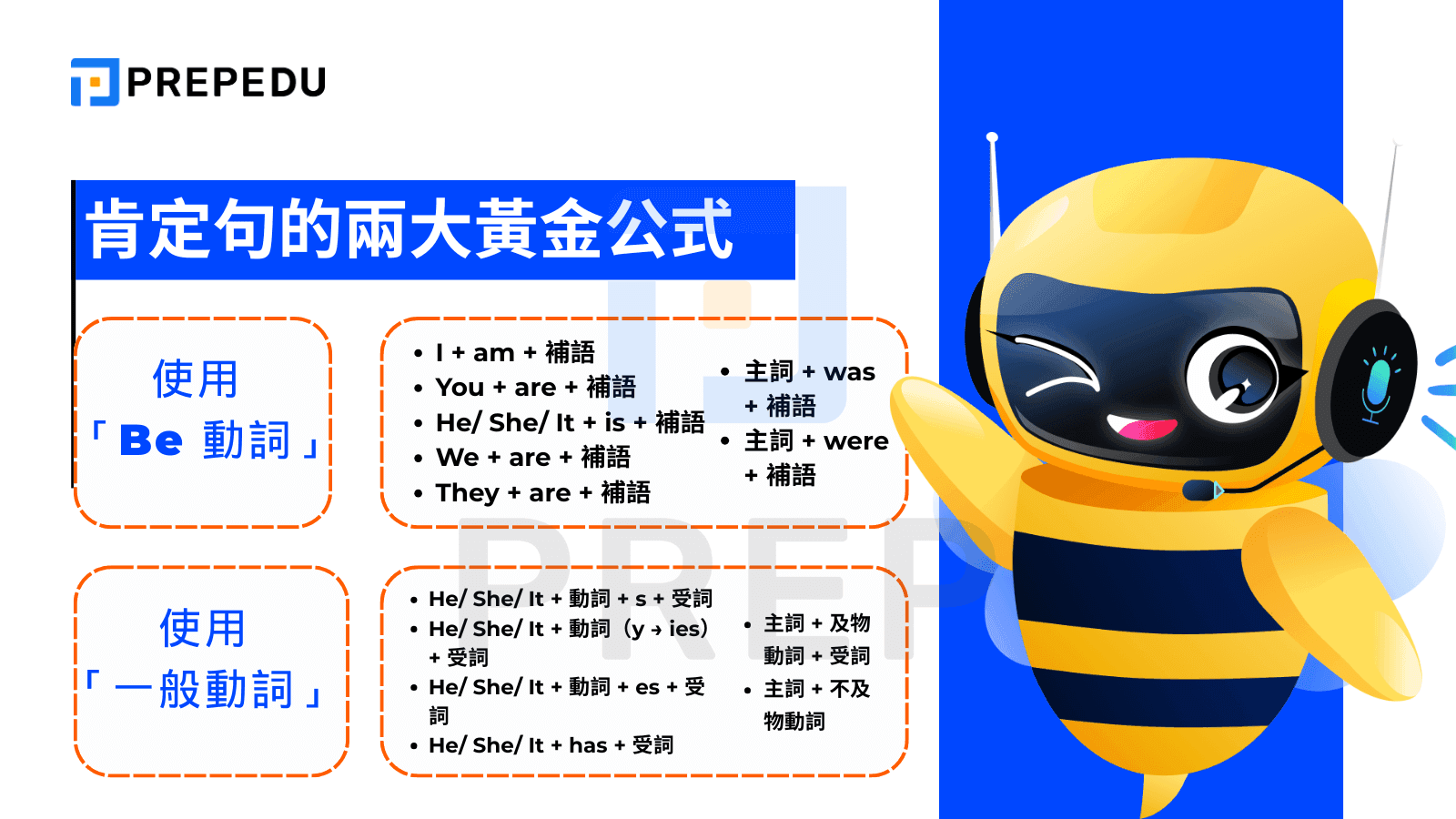肯定句英文(Affirmative Sentence)終極指南:從零到精通的結構,範例與常見錯誤
什麼是肯定句英文?如何正確使用肯定句? 肯定句英文(Affirmative Sentence)是表達肯定意思,陳述事實或描述狀態的句子,不含 "not","never" 等否定詞。它是英語溝通的基礎結構,遵循「主詞 + 動詞 + 受詞/補語」的標準語序。掌握肯定句,您就能清晰表達想法,準確描述事件,並在TOEIC,IELTS等國際英語測驗中展現扎實的文法能力。
然而,許多華語學習者在建構肯定句時反覆犯下三大核心錯誤:Be動詞與一般動詞混用,忽略第三人稱單數動詞變化,以及不規則動詞過去式錯誤。這些錯誤源於中英文法結構的根本差異,若不及時糾正,將嚴重影響您的英語表達準確度和考試成績。
本文由PREPEDU.COM資深英語教學團隊精心編撰,為您提供從基礎到進階的完整肯定句學習路徑。您將學習兩大黃金公式,12種時態應用,句型轉換技巧,並透過真實情境例句和實戰練習,徹底掌握肯定句英文的所有知識點,讓英語溝通更流暢自然。

I. 什麼是肯定句英文(Affirmative Sentence)?
肯定句英文(Affirmative Sentence)是用來陳述事實,表達肯定意思或描述狀態的句子,不含否定詞如 "not","never" 或 "no"。這類句子構成英語溝通的基礎,讓您能清晰表達想法,描述事件或陳述真相。
根據牛津英語文法詞典的定義,肯定句是「陳述事實為真的句子; 對提出或隱含的問題回答『是』」。柯林斯詞典則指出,「肯定子句是正面的,不含否定詞」。
肯定句 vs. 否定句 vs. 疑問句:
|
句型 |
功能 |
結構特點 |
範例 |
|
肯定句英文 |
陳述事實或表達肯定意思 |
主詞 + 動詞 + 其他成分,無否定詞 |
She speaks French fluently.(她法語說得很流利。) |
|
否定句英文 |
表達否定或拒絕 |
主詞 + 助動詞英文 + not + 動詞 + 其他成分 |
She does not speak German.(她不會說德語。) |
|
疑問句英文 |
提出問題或詢問資訊 |
助動詞/Be動詞 + 主詞 + 動詞 + 其他成分 + ? |
Does she speak German?(她會說德語嗎?) |
II. 英文肯定句的兩大黃金公式
掌握肯定句英文的核心在於理解兩種基本句型結構。第一種使用 Be 動詞來描述狀態,身份或特徵,第二種則使用一般動詞來表達動作或行為。這兩種公式涵蓋了日常溝通中超過90%的肯定句使用場景,讓您能夠自信地表達各種想法。肯定句的基本結構遵循主詞 + 動詞英文 + 受詞(或補語)的標準語序,這與中文的靈活語序有著根本差異。
1. 公式一:使用「Be 動詞」陳述狀態與身份
Be 動詞在肯定句英文中扮演連接主詞與其狀態,身份或特徵的角色。這個動詞會根據主詞和英文時態改變形式,您需要熟練掌握現在式和過去式的所有變化。
1.1. 現在式(am, is, are)的應用場景與主詞搭配
|
主詞類型 |
肯定句英文結構 |
範例 |
|
第一人稱單數(I) |
I + am + 補語 |
|
|
第二人稱(You) |
You + are + 補語 |
|
|
第三人稱單數(He/She/It) |
He/She/It + is + 補語 |
|
|
第一人稱複數(We) |
We + are + 補語 |
|
|
第三人稱複數(They) |
They + are + 補語 |
|
1.2. 過去式(was, were)的時光回溯用法
|
主詞類型 |
肯定句英文結構 |
範例 |
|
單數主詞(I/ He/ She/ It) |
主詞 + was + 補語 |
|
|
複數主詞(We/ You/ They) |
主詞 + were + 補語 |
|

2. 公式二:使用「一般動詞」描述動作與行為
一般動詞讓您能夠表達各種動作,活動和行為。這類肯定句英文的使用需要特別注意主詞與時態的配合,尤其是第三人稱單數的特殊變化規則。
2.1. 關鍵規則:第三人稱單數的動詞變化(-s/-es)
|
動詞類型 |
肯定句英文結構 |
範例 |
|
一般動詞(+s) |
He/ She/ It + 動詞+s + 受詞 |
|
|
子音+y結尾(+ies) |
He/ She/ It + 動詞(y → ies)+ 受詞 |
|
|
s/ x /ch /sh 結尾(+es) |
He/ She/ It + 動詞+es + 受詞 |
|
|
不規則變化(have → has) |
He/ She/ It + has + 受詞 |
|
2.2. 及物動詞與不及物動詞在肯定句中的基礎應用
|
動詞類型 |
肯定句英文結構 |
範例 |
|
及物動詞(需受詞) |
主詞 + 及物動詞 + 受詞 |
|
|
不及物動詞(無受詞) |
主詞 + 不及物動詞 |
|
III. 在不同時態中流暢使用肯定句英文
此部分是滿足肯定句例子搜尋意圖的核心。以下採用清晰的表格結構,將肯定句英文範例按難度(時態)分類,每個時態下提供2個高品質,貼近生活的範例,確保內容的豐富度和實用性。
1. 12種英文時態肯定句結構
|
時態(Tense) |
肯定句英文結構 |
範例 |
|
現在簡單式(Simple Present) |
S + V(s/es) +(O) |
|
|
現在進行式(Present Continuous) |
S + am/is/are + V-ing +(O) |
|
|
現在完成式(Present Perfect) |
S + have/has + V3/V-ed +(O) |
|
|
現在完成進行式(Present Perfect Continuous) |
S + have/has + been + V-ing +(O) |
|
|
過去簡單式(Simple Past) |
S + V2/V-ed +(O) |
|
|
過去進行式(Past Continuous) |
S + was/were + V-ing +(O) |
|
|
過去完成式(Past Perfect) |
S + had + V3/V-ed +(O) |
|
|
過去完成進行式(Past Perfect Continuous) |
S + had + been + V-ing +(O) |
|
|
未來簡單式(Simple Future) |
S + will + V(bare) +(O) |
|
|
未來進行式(Future Continuous) |
S + will + be + V-ing +(O) |
|
|
未來完成式(Future Perfect) |
S + will + have + V3/V-ed +(O) |
|
|
未來完成進行式(Future Perfect Continuous) |
S + will + have + been + V-ing +(O) |
|

2. 情態助動詞肯定句英文結構
在本節中,我們將整理情態助動詞的肯定句英文結構,依照不同語意功能(如能力、義務、可能性與意願)分類,並透過範例說明其具體用法與語句組成方式。這將幫助學習者精準掌握句型構造,提升語法表達力。
|
情態助動詞類型 |
肯定句英文結構 |
範例 |
|
能力(can/ could) |
主詞 + can/could + 動詞原形 + 其他成分 |
|
|
義務(should/ must) |
主詞 + should/must + 動詞原形 + 其他成分 |
|
|
可能性(may/ might) |
主詞 + may/might + 動詞原形 + 其他成分 |
|
|
意願(will/ would) |
主詞 + will/would + 動詞原形 + 其他成分 |
|

IV. 從肯定句英文到靈活:句型轉換的實用技巧
提供超越基礎定義的附加價值。使用步驟化,條列式的教學方法,展示如何進行肯定句英文的句型轉換。這個部分能極大提升文章的實用性,滿足使用者潛在的延伸需求。
1. 技巧一:如何將肯定句無縫轉為「否定句」
步驟化轉換方法:
-
步驟一:識別句中動詞類型(Be動詞或一般動詞)
-
步驟二:在Be動詞後加入 "not",或在一般動詞前加入 "do/does/did + not"
-
步驟三:使用助動詞時,一般動詞需還原成原形
實際轉換範例:
|
肯定句英文 |
否定句 |
|
Amy Chen is the head of the English department at XYZ University.(陳艾咪是XYZ大學英文系主任。) |
Amy Chen is not the head of the English department at XYZ University.(陳艾咪不是XYZ大學英文系主任。) |
|
Students at National Taiwan University study affirmative sentence patterns systematically.(台灣大學的學生系統性地學習肯定句型。) |
Students at National Taiwan University do not study affirmative sentence patterns systematically.(台灣大學的學生不會系統性地學習肯定句型。) |
|
Lin Jia-hui works at Google Taiwan headquarters in Taipei 101.(林佳慧在台北101的Google台灣總部工作。) |
Lin Jia-hui does not work at Google Taiwan headquarters in Taipei 101.(林佳慧不在台北101的Google台灣總部工作。) |
|
Wong Ka-ming from Hong Kong completed the TOEIC preparation course last month.(來自香港的黃嘉明上個月完成了多益準備課程。) |
Wong Ka-ming from Hong Kong did not complete the TOEIC preparation course last month.(來自香港的黃嘉明上個月沒有完成多益準備課程。) |
2. 技巧二:如何將肯定句優雅轉為「疑問句」
步驟化轉換方法:
-
步驟一:Be動詞句型將Be動詞移至句首
-
步驟二:一般動詞句型在句首加入助動詞(Do/Does/Did),一般動詞還原成原形
-
步驟三:句末加上問號
實際轉換範例:
|
肯定句英文 |
否定句 |
|
You are ready for the IELTS Academic Writing examination.(你已準備好參加雅思學術寫作考試。) |
Are you ready for the IELTS Academic Writing examination?(你準備好參加雅思學術寫作考試了嗎?) |
|
Kevin studies TOEFL vocabulary after school every day.(凱文每天放學後學習托福單字。) |
Does Kevin study TOEFL vocabulary after school every day?(凱文每天放學後學習托福單字嗎?) |
|
They completed their mock speaking tests last Friday.(他們上週五完成了模擬口說測驗。) |
Did they complete their mock speaking tests last Friday?(他們上週五完成了模擬口說測驗嗎?) |
|
Kelly and her classmates are preparing for the GEPT High-Intermediate test.(凱莉和她的同學正在準備全民英檢中高級測驗。) |
Are Kelly and her classmates preparing for the GEPT High-Intermediate test?(凱莉和她的同學正在準備全民英檢中高級測驗嗎?) |
3. 進階技巧:如何使用助動詞(do/does/did)來「強調」肯定語氣
在肯定句英文中加入助動詞 do/does/did 能夠強調動作的真實性或說話者的堅定態度。這個技巧在口語和正式寫作中都能有效增強表達力度,特別適用於反駁他人質疑或表達強烈確信時使用。
強調式肯定句結構:
主詞 + do/does/did + 動詞原形 + 其他成分
實際應用範例:
-
Our team do value the feedback collected during the peer review sessions.(我們團隊確實重視在同儕回饋討論中蒐集到的意見。)
-
Professor Liu from NTU’s Department of Foreign Languages does believe that consistent writing practice leads to significant improvements in IELTS scores.(來自台灣大學外文系的劉教授確實相信持續的寫作練習能大幅提升雅思分數。)
-
We did complete all 50 affirmative sentence transformation exercises in the workbook yesterday afternoon at the National Central Library.(我們昨天下午在國家圖書館確實完成了練習本中所有50個肯定句轉換練習。)
-
Hsu Yi-chun does attend every TOEFL strategy workshop, even on weekends and holidays.(許宜君就算在週末或假日,也確實參加每一場TOEFL策略工作坊。)
V. 避開學習陷阱:三大常見錯誤深度解析
這些錯誤源於中文和英文語法結構的根本差異,理解並糾正這些問題將大幅提升您的英語準確度。
1. 錯誤一:Be 動詞與一般動詞的混用
許多學生因受中文語法影響,會在同一個肯定句英文中同時使用 Be 動詞和一般動詞。英文句型結構規定一個簡單句只能有一個主要動詞,這是與中文最大的差異之一。
|
錯誤句子 |
正確句子 |
錯誤原因分析 |
|
❌ Chen Wei-ting from Tainan is study English grammar at PREP.(陳偉婷從台南是學習PREP的英語文法。) |
|
不能同時使用 Be 動詞(is)和一般動詞原形(study)。應選擇現在簡單式(studies)表示習慣,或現在進行式(is studying)表示正在進行的動作。 |
|
❌ I am go to National Taiwan University every day.(我是去台灣大學每天。) |
|
Be 動詞後需搭配形容詞英文,名詞英文或動詞-ing形式,不能直接接動詞原形(go)。描述習慣用現在簡單式,描述正在進行的動作用現在進行式。 |
|
❌ Wang Xiao-hua and Liu Ming-chen are work at Hsinchu Science Park.(王小華和劉明辰是工作在新竹科學園區。) |
|
混淆了簡單式和進行式的肯定句英文結構。陳述長期事實用現在簡單式,強調當前狀態用現在進行式。 |
2. 錯誤二:忽略關鍵的第三人稱單數動詞變化
第三人稱單數主詞(he, she, it 或單數名詞)搭配現在簡單式時,動詞必須加 -s 或 -es。這個規則在中文中不存在,因此是華語學習者在使用肯定句英文時最容易忽略的重點。
|
錯誤句子 |
正確句子 |
錯誤原因分析 |
|
❌ Dr. Lin from National Chengchi University teach applied linguistics every Tuesday.(來自政治大學的林博士每週二教授應用語言學。) |
✅ Dr. Lin from National Chengchi University teaches applied linguistics every Tuesday.(來自政治大學的林博士每週二教授應用語言學。) |
第三人稱單數主詞(Dr. Lin)搭配現在簡單式,動詞必須加 -es。這是肯定句英文中最基本但最容易被忽略的規則。 |
|
❌ Wong Mei-ling from Hong Kong study TOEIC vocabulary for two hours daily.(來自香港的黃美玲每天學習多益詞彙兩小時。) |
✅ Wong Mei-ling from Hong Kong studies TOEIC vocabulary for two hours daily.(來自香港的黃美玲每天學習多益詞彙兩小時。) |
動詞 study 遇第三人稱單數需將 y 變 i 加 es,成為 studies。這是子音+y結尾動詞的特殊變化規則。 |
|
❌ The experienced instructor at PREP Taipei explain complex grammar concepts clearly.(PREP台北的資深講師清楚地解釋複雜的文法概念。) |
✅ The experienced instructor at PREP Taipei explains complex grammar concepts clearly.(PREP台北的資深講師清楚地解釋複雜的文法概念。) |
單數名詞(instructor)視為第三人稱單數,動詞需加 -s。即使主詞較長,仍需注意動詞變化。 |
|
❌ It work perfectly when students practice consistently.(當學生持續練習時,它運作得很好。) |
✅ It works perfectly when students practice consistently.(當學生持續練習時,它運作得很好。) |
代名詞 It 屬第三人稱單數,在肯定句英文中動詞必須加 -s,成為 works。 |
3. 錯誤三:不規則動詞的過去式變化錯誤
不規則動詞的過去式沒有固定規則,需要個別記憶。許多學生會錯誤地為這些動詞加上 -ed 字尾,這在建構肯定句英文時會造成嚴重的文法錯誤。
|
錯誤句子 |
正確句子 |
錯誤原因分析 |
|
❌ Chen Ming-yu goed to the IELTS examination center in Taipei Main Station yesterday.(陳明宇昨天去了台北車站的雅思考試中心。) |
✅ Chen Ming-yu went to the IELTS examination center in Taipei Main Station yesterday.(陳明宇昨天去了台北車站的雅思考試中心。) |
go 的過去式是不規則變化 went,不能使用規則變化 goed。這是肯定句英文中最常見的不規則動詞錯誤之一。 |
|
❌ Liu Shu-fen from Kaohsiung taked the TOEIC Speaking and Writing test last Saturday.(來自高雄的劉淑芬上週六參加了多益口說寫作測驗。) |
✅ Liu Shu-fen from Kaohsiung took the TOEIC Speaking and Writing test last Saturday.(來自高雄的劉淑芬上週六參加了多益口說寫作測驗。) |
take 的過去式是 took,不遵循規則變化。不規則動詞需要透過大量閱讀和練習來記憶。 |
|
❌ We writed comprehensive grammar notes during Professor Wang's lecture at National Taiwan University.(我們在台灣大學王教授的講座期間寫了綜合文法筆記。) |
✅ We wrote comprehensive grammar notes during Professor Wang's lecture at National Taiwan University.(我們在台灣大學王教授的講座期間寫了綜合文法筆記。) |
write 的過去式是 wrote,不是 writed。在肯定句英文中使用正確的不規則過去式至關重要。 |
|
❌ Zhang Wei-jie from Hong Kong buyed three IELTS preparation books at Eslite Bookstore Causeway Bay.(來自香港的張偉傑在誠品書店銅鑼灣店買了三本雅思準備書籍。) |
✅ Zhang Wei-jie from Hong Kong bought three IELTS preparation books at Eslite Bookstore Causeway Bay.(來自香港的張偉傑在誠品書店銅鑼灣店買了三本雅思準備書籍。) |
buy 的過去式是 bought,屬於母音和子音都改變的不規則變化。 |
VI. 實戰演練:立即檢驗你的「英文肯定句」學習成果
您已經學習了肯定句英文的完整知識體系,現在是將理論轉化為實際能力的時刻。以下三種練習將從不同角度測試您對肯定句英文的掌握程度:句型識別能力,結構轉換技巧,以及動詞變化的實際應用。完成這些練習後,您將清楚了解自己的學習進度和需要加強的領域。
1. 練習一:火眼金睛——肯定句辨識挑戰
練習說明:以下10個句子中,請挑選出所有的肯定句英文。
-
Lin Wei-chen from PREP Taichung studies English grammar systematically every weekend.
-
Do students at National Taiwan University understand affirmative sentence structures?
-
Wong Ka-man from Hong Kong did not attend the TOEIC workshop yesterday.
-
I am currently preparing for my IELTS Academic examination at 247 Xinyi Center.
-
Is Chen Ming-hsuan a professional English instructor at Taipei 101?
-
We completed all the affirmative sentence transformation exercises in the comprehensive workbook.
-
The language center does not open on Sundays and national holidays.
-
Students at PREP practice affirmative sentence construction skills through interactive multimedia exercises regularly.
-
Will Liu Shu-fen join the advanced business English communication class next semester?
-
Professor Wang from National Chengchi University explains linguistic concepts using contemporary examples very clearly.
答案:句子 1, 4, 6, 8, 10 是肯定句英文。
詳細解釋:
-
肯定句英文(1, 4, 6, 8, 10):這些句子陳述事實或狀態,不含否定詞(not, never, no)或疑問結構,符合肯定句的所有特徵。
-
疑問句(2, 5, 9):這些句子以助動詞(Do, Is, Will)或Be動詞開頭,句末有問號,目的是詢問資訊而非陳述事實。
-
否定句(3, 7):這些句子包含否定詞 "not",表達否定意思,因此不屬於肯定句範疇。
2. 練習二:舉一反三——句型轉換大師
練習說明:請將以下10個肯定句英文進行轉換。句子1-5改為否定句,句子6-10改為疑問句。
-
Zhang Wei-ting from Hsinchu Science Park is an experienced software engineer.
-
Students at PREP Banqiao Center study TOEIC vocabulary diligently every evening.
-
Chen Yu-hsuan from Taichung completed the intensive IELTS preparation course successfully last month.
-
Wong Mei-ling from Hong Kong works at an international consulting firm in Central.
-
We are thoroughly prepared for the comprehensive grammar examination next Monday.
-
You understand the fundamental principles of affirmative sentence construction clearly.
-
Liu Jia-hui from National Taiwan Normal University teaches advanced English writing courses professionally.
-
The students from Kaohsiung attended the comprehensive grammar workshop at PREP last Saturday.
-
Lin Ming-chen from Taipei is currently preparing his application materials for overseas graduate programs.
-
They practice affirmative sentence patterns through interactive online exercises consistently every day.
解答
改為否定句(1-5):
-
Zhang Wei-ting from Hsinchu Science Park is not an experienced software engineer.
-
Students at PREP Banqiao Center do not study TOEIC vocabulary diligently every evening.
-
Chen Yu-hsuan from Taichung did not complete the intensive IELTS preparation course successfully last month.
-
Wong Mei-ling from Hong Kong does not work at an international consulting firm in Central.
-
We are not thoroughly prepared for the comprehensive grammar examination next Monday.
改為疑問句(6-10):
6. Do you understand the fundamental principles of affirmative sentence construction clearly?
7. Does Liu Jia-hui from National Taiwan Normal University teach advanced English writing courses professionally?
8. Did the students from Kaohsiung attend the comprehensive grammar workshop at PREP last Saturday?
9. Is Lin Ming-chen from Taipei currently preparing his application materials for overseas graduate programs?
10. Do they practice affirmative sentence patterns through interactive online exercises consistently every day?
3. 練習三:文法高手——動詞形式填空測驗
練習說明:請在空格中填入括號內動詞的正確形式,完成這些肯定句英文。
-
Professor Lin from National Taiwan University ________(teach)applied linguistics to graduate students every Tuesday and Thursday.
-
I ________(be)a dedicated English learner at PREP Zhongshan Center for the past three years.
-
Chen Wei-jie and his colleagues from Hsinchu Science Park ________(complete)their TOEIC preparation course last December.
-
Wong Shu-fen from Hong Kong ________(study)English grammar systematically using the comprehensive PREP curriculum materials.(
-
We ________(be)completely ready for the IELTS Academic Writing examination next Saturday morning.
-
Liu Ming-hsuan from Taichung ________(explain)the fundamental concepts of affirmative sentences to his study group yesterday.
-
The experienced instructor at PREP Taipei ________(practice)innovative teaching methodologies in every grammar class regularly.
-
Students from National Chengchi University ________(learn)advanced affirmative sentence construction techniques through interactive multimedia exercises.
-
Zhang Yu-ting from Kaohsiung ________(attend)the comprehensive TOEIC Speaking and Writing workshop at PREP last Saturday afternoon.
-
Lin Jia-ming from Hong Kong ________(be)fluent in English, Mandarin, and Cantonese after studying at PREP for two years.
解答
-
teaches(第三人稱單數現在式,teach加es)
-
have been(現在完成式,表示持續狀態,for the past three years是明顯提示)
-
completed(過去簡單式,last December是過去時間點)
-
studies(第三人稱單數現在式,study變y為i加es)
-
are(第一人稱複數現在式 Be 動詞)
-
explained(過去簡單式,yesterday是過去時間標記)
-
practices(第三人稱單數現在式,regularly表示習慣性動作)
-
learn(第三人稱複數現在式,複數主詞動詞用原形)
-
attended(過去簡單式,last Saturday是明確的過去時間)
-
is(第三人稱單數現在式 Be 動詞,after studying表示現在的狀態)
VII. 肯定句英文的進階問答
此部分通過獨特的問題提供差異化內容,建立肯定句英文的權威性。每個問題都用簡潔的段落呈現答案,這些問題旨在填補其他文章可能忽略的知識盲點。
1.「肯定句」與「陳述句」有何不同?
這兩個文法術語經常被混淆,但實際上有明確的區別。
-
陳述句(Declarative Sentence)是根據句子功能分類,指用來陳述事實或表達意見的句子,可以是肯定或否定。
-
肯定句英文則是根據句子語氣分類,專指不含否定詞的陳述。
換句話說,肯定句是陳述句的一個子類別:所有肯定句都是陳述句,但並非所有陳述句都是肯定句(否定陳述句就不是肯定句)。
例如,「Chen Wei-ting studies at PREP」(陳偉婷在PREP學習)是肯定陳述句,而「Chen Wei-ting does not study at PREP」(陳偉婷不在PREP學習)是否定陳述句。這個區分幫助您更精確地理解英語句法結構。
2. 所有不含「not」的句子都是肯定句嗎?
不一定。雖然肯定句英文的明顯特徵是不含 "not",但某些句子即使沒有 "not" 也可能傳達否定意思。例如:「Lin Shu-fen from Taipei rarely studies grammar on weekends」(來自台北的林淑芬週末很少學習文法)雖然沒有 "not",但副詞 "rarely"(很少)本身就帶有否定含義,因此這不能算是純粹的肯定句。其他類似的否定詞包括 never(從不),hardly(幾乎不),seldom(很少),barely(勉強),scarcely(幾乎沒有)。此外,疑問句如「Does Wang Xiao-ming study English?」(王小明學英語嗎?)也不含 "not" 但不屬於肯定句。因此,判斷肯定句英文時需要理解句子的整體意義和語法功能,而不僅僅看是否有 "not" 這個詞。
查看更多其他常用的頻率副詞:英文頻率副詞最全指南 (Adverbs of Frequency)
4. 英文肯定句的結構與中文語法習慣有何根本差異?
肯定句英文與中文句子在結構上有三個根本差異,理解這些差異能幫助華語學習者避免常見錯誤。
-
第一,語序固定性:英文嚴格遵循「主詞 + 動詞 + 受詞」(Subject-Verb-Object, SVO)的固定語序,而中文的語序更靈活。例如,英文必須說「Wang Xiao-ming studies English at PREP」(王小明在PREP學習英語),不能任意調整語序。
-
第二,動詞形態變化:英文動詞會根據主詞和時態變化形式(如第三人稱單數加 -s,過去式變化),中文動詞則保持不變。例如,「he studies」中的 studies 必須加 -s,但中文「他學習」中的「學習」不需變化。
-
第三,動詞必須性:英文肯定句必須包含明確的動詞,即使是描述狀態也需要 Be 動詞,而中文可以省略「是」。例如,中文可以說「我學生」,但英文必須是「I am a student」,不能省略 am。這個差異導致許多華語學習者在建構肯定句英文時會遺漏 Be 動詞。
結論
透過這份英文肯定句(Affirmative Sentence),您已經完整掌握了從基礎到進階的肯定句知識,包括核心結構、時態應用、句型轉換技巧及常見錯誤解析。掌握這些內容不僅能讓您的英語表達更清晰、自然,也能在TOEIC、IELTS等國際英語測驗中展現扎實的文法能力。
曾經質疑自己是否能夠達標嗎?PREPEDU.COM Test Practice 超越單純題目練習,依據您當前表現科學預估達分機率。
運用數千位優秀學員的成功數據,系統深度剖析分數變化規律,為每個特定目標量身訂製學習藍圖。不論追求雅思 6.5 分或多益 850 分,皆有對應的精準攻略。
可視化追蹤介面清楚呈現您的當前定位與距離目標的剩餘路程。眾多學員經過 4-6 週規律訓練後,雅思分數躍升 0.5-1.0 分,多益成績攀升 100-200 分。
成就源自縝密規劃而非偶然。讓 PREP Test Practice 架起通往理想的堅實橋樑!

你好!我叫黃秋賢。現在在網站 prepedu.com 的部落格擔任產品內容經理。
我有超過5年的英語、韓語等外語自學經驗,並準備過 IELTS、TOEIC、TOPIK 等考試,累積了豐富的實戰知識,也曾協助數千位在語言學習上遇到困難的人。希望以上的分享能幫助大家在家中更有效率地自學!
評論











